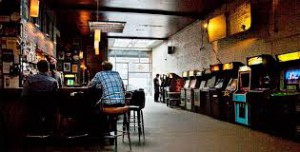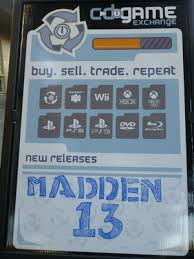Art World Field Guide Proposal
The trajectory of the “togetherness” of the gaming community has fluctuated in the years that video games and card games have become popular. In the beginning, people would come together to play simple arcade-style games like Pong. As the games became more mainstream and arcades began popping up in more and more places, the social aspect of gaming blew up. Even as consoles continued to update, physically being in the same place as other gamers was an important aspect of playing games together, whether in an arcade or at home. As video gaming companies began to push for online connectivity, the landscape of social gaming radically changed. Where you used to only be able to play a certain game with a friend in your living room or against someone at an arcade, you could now go online and play with people across the world, even if you were thousands of miles apart. The “place” of video games changed from being very geographically dependant to depending more on who had the same game and a connection to play with you. This is a good example of the “convergence of place” (p.473) that Dueze mentions in his article about media life. This digital, social landscape of gaming continued to expand to the point where some multiplayer games these days don’t even have the option to access the multiplayer function unless it’s online.
In the digitalization of social gaming, I have begun to notice that the original, old-school style of getting together to play games is starting to make a resurgence in an interesting way. Because some of the modern consoles are starting to phase out social gaming where the players are physically in the same place, gamers are trying to reclaim that experience. Arcades and arcades combined with bars, barcades, have been becoming more and more popular in older generations trying to relive the social gaming experience.
What I propose to do my field guide on is the landscape of public social gaming in Eugene. To me, the environment seems to be rather diverse with a good distribution of arcades and barcades that are growing in attendance. For people my age, going to one of these places doesn’t even seem like something for a niche market; engaging in social gaming in public is becoming mainstream again like it once was. What I plan to discuss about the arcades and barcades is what kind of games and atmosphere they have. With these sorts of institutions they could focus on any number of things: classic games, a modern feel, pinball machines, racing games etc. The answers to these questions will also inform what kind of people go there – age, gender, in groups or alone, and other demographic concerns.
Something else that I want to explore as part of this field guide is places where people get together to play other sorts of games, like card games or board games. Even as social video gaming has ebbed and fluctuated in popularity, there seems to have always been a strong, albeit small, population that has engaged in this form of gaming, which almost always requires the players to be in the same physical space. I want to document and analyze the spaces that this sort of gaming happens as well. I’m imagining that this is going to yield different results than the arcades because the video game institutions are stationary businesses, while these card and board game meetings are transient groups. The places that host these meetings have to subsist on other businesses as well.
Finally, the last aspect of this ecology that I am going to investigate is going to be used game stores and game exchanges in town. Although gaming doesn’t necessarily happen at these businesses, I think it is an important aspect of the overall social gaming environment. An open exchange of games between players is the part of this environment that helps to replicate and keep up an essential part of the socializing – not only do people exchange their playing skills, but they also can exchange their actual games. In so doing they enter into a sort of system somewhat removed from time where players can collaborate even if they’ve never met or will never meet. These game exchanges really exemplify the idea of a live cycle of participation in this art world. Some people don’t want to play games anymore and they give theirs away here for new or continual gamers to take them and make them their own. It also gives gamers access to older games and systems that they could not get at a modern game store.
I have not totally figured out how this project will manifest in a transmedia context, but I do want to make a map of Eugene that highlights these places. Photos will be very important to document the differences in atmosphere and participants in these social gaming places. There might even be some way to incorporate actual gaming into this; we will have to see what develops.
Level Up Arcade: http://www.leveluparcade.com/
Blairally Vintage Arcade: http://www.yelp.com/biz/blairally-vintage-arcade-eugene-2
Shoryuken League: https://www.facebook.com/pages/Shoryuken-League/112145452263105
Parker Galactic LLC: https://www.facebook.com/parkergalactic
Putters: http://eugenesgamecentral.com/?page_id=6510
Addictive behaviors: http://www.yelp.com/biz/addictive-behaviors-eugene-2
CD and game exchange: http://cdgmexeug.com/


